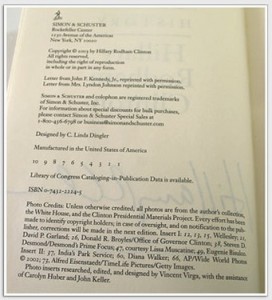 One of the questions we’re most often asked by those new to book collecting is, “How do I know if a book is truly a first edition?” While the indicators for first editions can vary from publisher to publisher, there are some general guidelines you can use as your starting point for identifying many first editions.
One of the questions we’re most often asked by those new to book collecting is, “How do I know if a book is truly a first edition?” While the indicators for first editions can vary from publisher to publisher, there are some general guidelines you can use as your starting point for identifying many first editions.
Dates
The very first places to look are the book’s copyright page and title page. The dates on these pages should match. The date you should be seeing is none other than the original publication date. There are occasions when you may see two dates, if for example, the book was copyrighted prior to publishing — in which case, you would see the copyright date and a “First Published” date, usually close to each other in time frame. Note: publication dates for other countries that may be listed on the copyright page have no bearing on the first edition status (in your country) of the book; however, the true “First Edition” would be the one printed in the author’s country.
Number Lines
Printers Key, more commonly referred to as Number Lines is a series of numbers appearing on the copyright page. This identifier became popular post WWII and has been utilized widely by publishers since. The sequence of numbers will be specific to publishers, but the general rules remain the same: the series of numbers will generally be between 10 and 1. If a 1 appears in the Number Line, it is a first edition (e.g. 10 9 8 7 6 5 4 3 2 1). If the Number Line concludes at 2, then it is a second edition (e.g. 10 9 8 7 6 5 4 3 2), and so forth.
Of course, these are general rules, to which there are always exceptions. For example, you might find a book with a second edition Number Line and the words “First Edition” — both appearing on the copyright page. In such cases, the book may in fact be a second edition and the publisher failed to remove the words “First Edition” in reprinting; or the book is indeed a first edition which just happens to have a misleading Number Line (concluding at 2), and the words “First Edition” will be removed from the second print and all subsequent reprints. In these cases, it is best to consult the publisher’s own guide to first editions.
Printing/Impression
When a book is printed for the first time by a particular publisher, this is called a First Impression, or more commonly, a First Printing. The terms are synonymous for “First Edition” so far as publishers are concerned. All subsequent prints would appear as “Second Printing” and so on. Confusion may come in when you find a “Second Printing Before Publication” identifier. This simply means that you are looking at a second edition which was printed prior to its specific release date (i.e. before the book went on sale to the public). This can occur when pre-orders exceed available stock. For book collectors, it is important to know that while some publishers may consider all prints within an edition to be a “First Edition,” for your purposes, only books that are both First Printing and First Edition are a true “First Edition.”
Book Club Editions
The first thing to do in identifying a BCE is to look at the dust jacket flaps for the words “Book Club Edition,” followed by the copyright page where you will sometimes (not always) find the name of the book club. As a rule of thumb, book club editions are usually not price marked on the dust jacket. Size is often a factor, with book club editions usually being smaller than the regular hard cover edition, or somewhat larger than trade paperbacks in the case of paperback book clubs. Another fairly common identifier is a “blind stamp” impressed into the back of a hardcover. You’ll generally find this on the back cover, near the spine, and toward the bottom. It’s called a “blind stamp” because the impression is made without the use of ink.

Leave a Reply